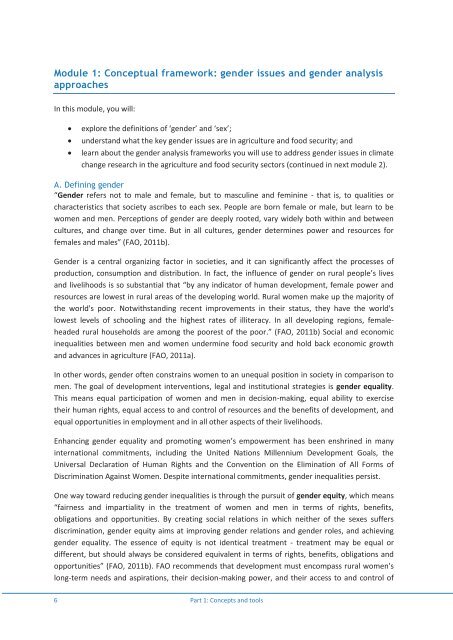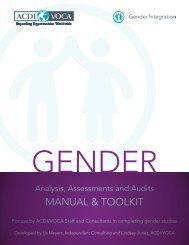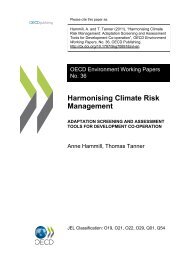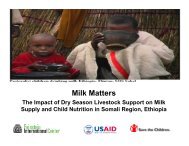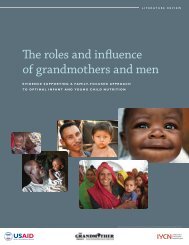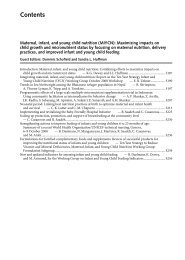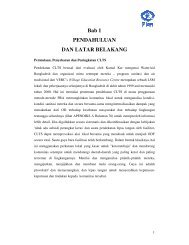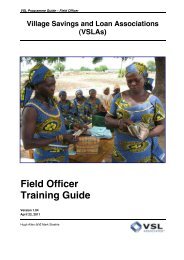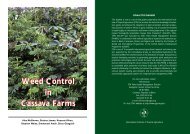Gender and climate change research in - FAO
Gender and climate change research in - FAO
Gender and climate change research in - FAO
You also want an ePaper? Increase the reach of your titles
YUMPU automatically turns print PDFs into web optimized ePapers that Google loves.
Module 1: Conceptual framework: gender issues <strong>and</strong> gender analysis<br />
approaches<br />
In this module, you will:<br />
<br />
<br />
<br />
explore the def<strong>in</strong>itions of ‘gender’ <strong>and</strong> ‘sex’;<br />
underst<strong>and</strong> what the key gender issues are <strong>in</strong> agriculture <strong>and</strong> food security; <strong>and</strong><br />
learn about the gender analysis frameworks you will use to address gender issues <strong>in</strong> <strong>climate</strong><br />
<strong>change</strong> <strong>research</strong> <strong>in</strong> the agriculture <strong>and</strong> food security sectors (cont<strong>in</strong>ued <strong>in</strong> next module 2).<br />
A. Def<strong>in</strong><strong>in</strong>g gender<br />
“<strong>Gender</strong> refers not to male <strong>and</strong> female, but to mascul<strong>in</strong>e <strong>and</strong> fem<strong>in</strong><strong>in</strong>e - that is, to qualities or<br />
characteristics that society ascribes to each sex. People are born female or male, but learn to be<br />
women <strong>and</strong> men. Perceptions of gender are deeply rooted, vary widely both with<strong>in</strong> <strong>and</strong> between<br />
cultures, <strong>and</strong> <strong>change</strong> over time. But <strong>in</strong> all cultures, gender determ<strong>in</strong>es power <strong>and</strong> resources for<br />
females <strong>and</strong> males” (<strong>FAO</strong>, 2011b).<br />
<strong>Gender</strong> is a central organiz<strong>in</strong>g factor <strong>in</strong> societies, <strong>and</strong> it can significantly affect the processes of<br />
production, consumption <strong>and</strong> distribution. In fact, the <strong>in</strong>fluence of gender on rural people’s lives<br />
<strong>and</strong> livelihoods is so substantial that “by any <strong>in</strong>dicator of human development, female power <strong>and</strong><br />
resources are lowest <strong>in</strong> rural areas of the develop<strong>in</strong>g world. Rural women make up the majority of<br />
the world's poor. Notwithst<strong>and</strong><strong>in</strong>g recent improvements <strong>in</strong> their status, they have the world's<br />
lowest levels of school<strong>in</strong>g <strong>and</strong> the highest rates of illiteracy. In all develop<strong>in</strong>g regions, femaleheaded<br />
rural households are among the poorest of the poor.” (<strong>FAO</strong>, 2011b) Social <strong>and</strong> economic<br />
<strong>in</strong>equalities between men <strong>and</strong> women underm<strong>in</strong>e food security <strong>and</strong> hold back economic growth<br />
<strong>and</strong> advances <strong>in</strong> agriculture (<strong>FAO</strong>, 2011a).<br />
In other words, gender often constra<strong>in</strong>s women to an unequal position <strong>in</strong> society <strong>in</strong> comparison to<br />
men. The goal of development <strong>in</strong>terventions, legal <strong>and</strong> <strong>in</strong>stitutional strategies is gender equality.<br />
This means equal participation of women <strong>and</strong> men <strong>in</strong> decision-mak<strong>in</strong>g, equal ability to exercise<br />
their human rights, equal access to <strong>and</strong> control of resources <strong>and</strong> the benefits of development, <strong>and</strong><br />
equal opportunities <strong>in</strong> employment <strong>and</strong> <strong>in</strong> all other aspects of their livelihoods.<br />
Enhanc<strong>in</strong>g gender equality <strong>and</strong> promot<strong>in</strong>g women’s empowerment has been enshr<strong>in</strong>ed <strong>in</strong> many<br />
<strong>in</strong>ternational commitments, <strong>in</strong>clud<strong>in</strong>g the United Nations Millennium Development Goals, the<br />
Universal Declaration of Human Rights <strong>and</strong> the Convention on the Elim<strong>in</strong>ation of All Forms of<br />
Discrim<strong>in</strong>ation Aga<strong>in</strong>st Women. Despite <strong>in</strong>ternational commitments, gender <strong>in</strong>equalities persist.<br />
One way toward reduc<strong>in</strong>g gender <strong>in</strong>equalities is through the pursuit of gender equity, which means<br />
“fairness <strong>and</strong> impartiality <strong>in</strong> the treatment of women <strong>and</strong> men <strong>in</strong> terms of rights, benefits,<br />
obligations <strong>and</strong> opportunities. By creat<strong>in</strong>g social relations <strong>in</strong> which neither of the sexes suffers<br />
discrim<strong>in</strong>ation, gender equity aims at improv<strong>in</strong>g gender relations <strong>and</strong> gender roles, <strong>and</strong> achiev<strong>in</strong>g<br />
gender equality. The essence of equity is not identical treatment - treatment may be equal or<br />
different, but should always be considered equivalent <strong>in</strong> terms of rights, benefits, obligations <strong>and</strong><br />
opportunities” (<strong>FAO</strong>, 2011b). <strong>FAO</strong> recommends that development must encompass rural women's<br />
long-term needs <strong>and</strong> aspirations, their decision-mak<strong>in</strong>g power, <strong>and</strong> their access to <strong>and</strong> control of<br />
6 Part 1: Concepts <strong>and</strong> tools


